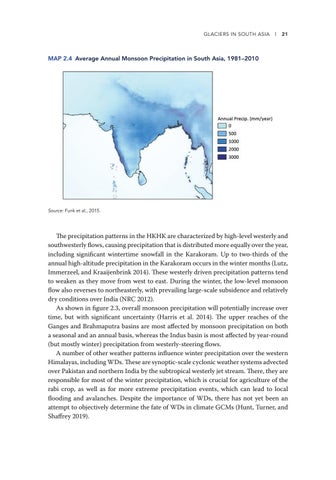Glaciers in South Asia l 21
MAP 2.4 Average Annual Monsoon Precipitation in South Asia, 1981–2010
Source: Funk et al., 2015.
The precipitation patterns in the HKHK are characterized by high-level westerly and southwesterly flows, causing precipitation that is distributed more equally over the year, including significant wintertime snowfall in the Karakoram. Up to two-thirds of the annual high-altitude precipitation in the Karakoram occurs in the winter months (Lutz, Immerzeel, and Kraaijenbrink 2014). These westerly driven precipitation patterns tend to weaken as they move from west to east. During the winter, the low-level monsoon flow also reverses to northeasterly, with prevailing large-scale subsidence and relatively dry conditions over India (NRC 2012). As shown in figure 2.3, overall monsoon precipitation will potentially increase over time, but with significant uncertainty (Harris et al. 2014). The upper reaches of the Ganges and Brahmaputra basins are most affected by monsoon precipitation on both a seasonal and an annual basis, whereas the Indus basin is most affected by year-round (but mostly winter) precipitation from westerly-steering flows. A number of other weather patterns influence winter precipitation over the western Himalayas, including WDs. These are synoptic-scale cyclonic weather systems advected over Pakistan and northern India by the subtropical westerly jet stream. There, they are responsible for most of the winter precipitation, which is crucial for agriculture of the rabi crop, as well as for more extreme precipitation events, which can lead to local flooding and avalanches. Despite the importance of WDs, there has not yet been an attempt to objectively determine the fate of WDs in climate GCMs (Hunt, Turner, and Shaffrey 2019).




